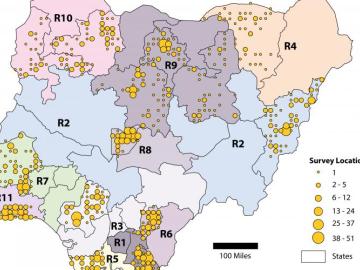Filter News
Area of Research
- (-) Materials for Computing (4)
- (-) National Security (7)
- (-) Nuclear Systems Modeling, Simulation and Validation (2)
- Advanced Manufacturing (3)
- Biology and Environment (11)
- Clean Energy (33)
- Climate and Environmental Systems (2)
- Computer Science (2)
- Energy Sciences (1)
- Fusion and Fission (1)
- Fusion Energy (4)
- Isotopes (1)
- Materials (29)
- Neutron Science (18)
- Nuclear Science and Technology (9)
- Supercomputing (21)
News Topics
- 3-D Printing/Advanced Manufacturing (2)
- Advanced Reactors (1)
- Big Data (1)
- Biomedical (2)
- Climate Change (1)
- Computer Science (5)
- Coronavirus (1)
- Cybersecurity (1)
- Energy Storage (3)
- Environment (2)
- Grid (1)
- Materials Science (3)
- Nanotechnology (1)
- National Security (2)
- Neutron Science (2)
- Nuclear Energy (1)
- Polymers (1)
- Security (1)
- Summit (2)
- Sustainable Energy (3)
- Transportation (2)
Media Contacts

In the quest for advanced vehicles with higher energy efficiency and ultra-low emissions, ORNL researchers are accelerating a research engine that gives scientists and engineers an unprecedented view inside the atomic-level workings of combustion engines in real time.

Oak Ridge National Laboratory researchers have developed a new family of cathodes with the potential to replace the costly cobalt-based cathodes typically found in today’s lithium-ion batteries that power electric vehicles and consumer electronics.

Researchers at Oak Ridge National Laboratory are developing a first-of-a-kind toolkit drawing on video game development software to visualize radiation data.

Jeff Johnson, nonproliferation research and development integration manager for ORNL’s National Security Sciences Directorate, has been honored by the American Nuclear Society

Six ORNL scientists have been elected as fellows to the American Association for the Advancement of Science, or AAAS.

Oak Ridge National Laboratory scientists helped count the population of Nigeria – all without leaving the lab.

Scientists at Oak Ridge National Laboratory and the University of Tennessee designed and demonstrated a method to make carbon-based materials that can be used as electrodes compatible with a specific semiconductor circuitry.

Four research teams from the Department of Energy’s Oak Ridge National Laboratory and their technologies have received 2020 R&D 100 Awards.

Horizon31, LLC has exclusively licensed a novel communication system that allows users to reliably operate unmanned vehicles such as drones from anywhere in the world using only an internet connection.

Oak Ridge National Laboratory’s high-resolution population distribution database, LandScan USA, became permanently available to researchers in time to aid the response to the novel coronavirus pandemic.




